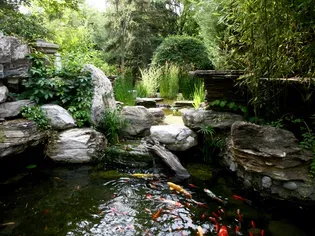How to Keep Aquarium Fish in Outdoor Fountains and Ponds
Updated on 04/26/24

Transform Your Outdoor Oasis: A Comprehensive Guide to Keeping Aquarium Fish in Fountains and Ponds
Elevate your backyard serenity with the vibrant beauty of aquarium fish. Contrary to popular belief, it's entirely possible to create a thriving aquatic ecosystem outside the confines of traditional aquariums. Whether you desire a tranquil fountain or a majestic pond, this comprehensive guide will empower you with the knowledge and techniques to successfully house aquarium fish in outdoor environments.
Creating a Thriving Aquarium in Your Fountain
Fountains, with their constant water movement and aeration, provide an ideal environment for certain types of fish. Here are some key considerations to ensure success:
- Fish Selection: Choose species that thrive in well-oxygenated, flowing water, such as goldfish, koi, or mosquito fish.
- Sizing: The fountain should be large enough to accommodate the fish's size and swimming space. A 10-gallon fountain is suitable for a small goldfish, while larger varieties require more space.
- Water Quality: Fountains lack filtration systems, so regular water changes are crucial. Aim for weekly 20% water changes to remove waste and maintain optimal water parameters.
- Temperature: Most aquarium fish can tolerate temperature fluctuations, but extreme temperatures can be detrimental. Consider using a fountain heater for colder climates or providing shade for hot summers.
- Shelter and Plants: Provide hiding places and plants to reduce stress and create a natural feel. Artificial plants or floating plants like water lettuce work well.
- Feeding: Feed fish sparingly, as excess food can quickly foul the water. Choose floating food pellets or sinking wafers that are suitable for the fish species you have.
Establishing a Thriving Aquarium in Your Pond
Ponds offer a wider range of possibilities for aquarium fish, as they provide more space and natural habitat. Follow these essential steps to create a thriving ecosystem:
- Pond Design: Ensure the pond is deep enough to prevent fish from freezing in winter. Provide a variety of depths and hiding places by incorporating shelves, rocks, or plants.
- Filter System: A filtration system is essential for maintaining water quality in ponds. Choose a filter that is appropriate for the pond size and fish population.
- Water Testing: Regularly test pond water for pH, ammonia, nitrite, and nitrate levels. This will help you identify and address any water quality issues.
- Plant Life: Plants are crucial for oxygenation, filtration, and food for fish. Consider a mix of floating, submerged, and emergent plants.
- Fish Selection: Choose fish species that are compatible with each other and the pond environment. Consider the size of the pond, water temperature, and amount of vegetation.
- Feeding: Feed fish a balanced diet appropriate for their species. Avoid overfeeding, as it can lead to water quality problems.
Examples of Aquarium Fish Thriving in Outdoor Fountains and Ponds
- Goldfish: Hardy and adaptable, goldfish are a popular choice for both fountains and ponds. They can tolerate a wide range of water temperatures and conditions.
- Koi: Known for their vibrant colors and graceful movements, koi are a striking addition to large ponds. They require ample space and high water quality.
- Mosquito Fish: These small, silver fish are effective mosquito larvae predators. They are suitable for small fountains and ponds where mosquito control is a concern.
- Weatherfish: With their unique appearance and ability to tolerate low oxygen levels, weatherfish are an interesting addition to ponds. They thrive in areas with dense vegetation.
- Fancy Guppies: Guppies with their flashy tails and vibrant colors can add a splash of beauty to small fountains. They enjoy well-oxygenated water and tolerate temperature fluctuations.
Additional Tips for Success
- Acclimate Slowly: Gradually introduce fish to their new outdoor environment over several hours to reduce stress.
- Monitor Fish Health: Observe fish regularly for signs of disease or stress. Isolate any sick fish immediately to prevent the spread of infection.
- Provide Shade: During hot summers, provide shade over fountains and ponds to protect fish from sunburn.
- Prepare for Winter: In colder climates, consider moving fish indoors or providing a heated enclosure for the winter months.
- Enjoy Your Oasis: Sit back, relax, and savor the beauty of your thriving outdoor aquarium. The vibrant colors and peaceful movements of fish will enhance your backyard oasis for years to come.
Conclusion
Creating an aquarium in an outdoor fountain or pond is a rewarding experience that brings the beauty of aquatic life into your backyard. By selecting appropriate fish species, maintaining water quality, and following the guidelines outlined in this comprehensive guide, you can successfully establish a thriving ecosystem that will provide years of enjoyment. Embrace the transformative power of aquarium fish and elevate your outdoor oasis into a sanctuary of serenity and wonder.
Explore More Pets

Freshwater Aquarium Filters
How to Deal With Cloudy Aquarium Water

Saltwater Aquarium Filters
How Do You Remove Chloramines From Tap Water?

Freshwater Aquariums & Habitat
Can I Keep My Koi Fish Inside?

Saltwater Aquariums & Habitat
14 Best Floating Plants for Your Aquarium

Freshwater Fish Health
How to Treat Ich on Freshwater Fish

Saltwater Fish Health
Fin Rot in Aquarium Fish

Freshwater Aquarium Filters
How to Do Aquarium Water Changes

Saltwater Fish Health
How Do Fish Get Parasites?